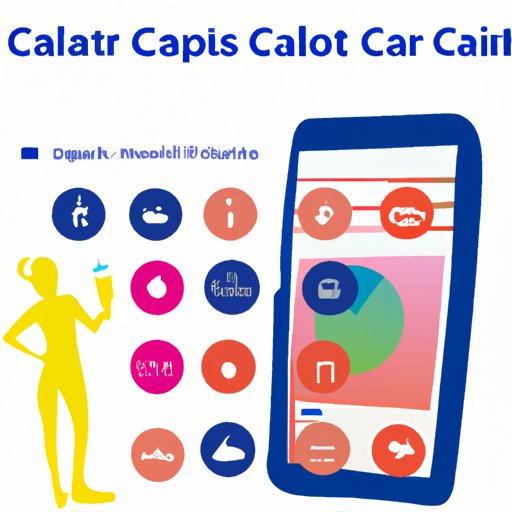Introduction
Achieving a calorie deficit is a key factor in successful weight loss. A calorie deficit occurs when you burn more calories than you consume. This means that your body has to pull energy from other sources, like fat stores, to meet its needs. It can be difficult to maintain a calorie deficit, but it’s important for those looking to lose weight or improve their overall health.
Stock up on high-fiber, low-calorie foods
High-fiber, low-calorie foods are great for achieving a calorie deficit because they fill you up without adding too many extra calories. Fiber helps slow digestion, which keeps you feeling full longer. High-fiber foods also help regulate blood sugar levels and promote regularity.
Examples of high-fiber, low-calorie foods include fruits, vegetables, legumes, grains, nuts, and seeds. Incorporating these into your diet is a great way to ensure that you’re getting the nutrition you need while still achieving a calorie deficit.
Count your daily calorie intake
The first step in achieving a calorie deficit is calculating your daily caloric needs. Everyone’s daily caloric needs are different, so it’s important to calculate yours based on your age, gender, height, weight, and activity level. The number of calories you should consume each day will depend on whether you’re trying to lose, gain, or maintain your current weight.
Once you know how many calories you should be consuming each day, it’s important to track your intake. There are a variety of apps and websites available to help you track what you eat, such as MyFitnessPal and LoseIt!. Tracking your calories can help you stay on track and make sure you’re staying within your caloric limit.
Choose nutrient-dense over processed food
Processed foods are often high in calories and low in nutrients. To achieve a calorie deficit, it’s important to choose nutrient-dense foods like fruits, vegetables, whole grains, lean proteins, and healthy fats. These types of foods provide your body with essential vitamins and minerals, as well as fiber and protein to keep you feeling full.
Examples of nutrient-dense foods include leafy greens, berries, oats, quinoa, lentils, eggs, salmon, and avocados. Choosing these types of foods instead of processed options will help you get the nutrients your body needs while still keeping your calorie count in check.

Cut back on alcohol consumption
Alcohol is high in empty calories, meaning it contains a lot of calories without providing any nutritional value. Consuming too much alcohol can prevent you from achieving a calorie deficit, as it can add hundreds of extra calories to your daily intake. It can also lead to poor decision making when it comes to food choices.
If you’re looking to reduce your alcohol consumption, there are a few strategies you can try. Limiting yourself to one or two drinks per week, alternating between alcoholic and non-alcoholic beverages, and opting for lower-calorie options like wine or light beer are all good ways to cut back.

Eat smaller meals more frequently
Eating smaller meals more frequently throughout the day is a great way to keep your hunger at bay while still achieving a calorie deficit. Eating this way allows you to spread out your calorie intake throughout the day, rather than consuming all your calories in one or two large meals. This prevents overeating, as well as helps keep your energy levels steady.
Some examples of healthy snacks you can enjoy between meals include fruits, yogurt, nuts, smoothies, veggie sticks with hummus, and hard boiled eggs. Eating small, healthy snacks throughout the day will help you stay within your caloric limit while still keeping your energy levels high.

Incorporate exercise into your daily routine
Exercise is an important part of any weight loss plan, and it’s especially important for those looking to achieve a calorie deficit. Regular physical activity helps speed up your metabolism, which helps you burn more calories. It also increases muscle mass, which helps your body burn more calories even when you’re not exercising.
There are a variety of exercises you can do to help you achieve a calorie deficit. Cardio activities like running, swimming, walking, and cycling are great for burning calories. Strength training exercises like weightlifting and bodyweight exercises can also help build muscle and increase your calorie burn.
Track progress with a food diary or calorie tracking app
Tracking your progress is an important part of achieving a calorie deficit. Keeping a food diary or using a calorie tracking app can help you stay on track and ensure that you’re meeting your goals. Writing down what you eat can help you become aware of your eating habits and make adjustments accordingly.
There are a variety of food diaries and calorie tracking apps available, such as MyFitnessPal and LoseIt!. These apps allow you to track your food intake, set goals, and monitor your progress. They’re a great way to stay motivated and stay on track with your calorie deficit.
Conclusion
Achieving a calorie deficit is an important part of any weight loss plan. By stocking up on high-fiber, low-calorie foods, counting your daily calorie intake, choosing nutrient-dense over processed food, cutting back on alcohol consumption, eating smaller meals more frequently, incorporating exercise into your daily routine, and tracking progress with a food diary or calorie tracking app, you can successfully reach your weight loss goals.
By following these tips, you’ll be able to create a healthy lifestyle that supports your weight loss goals and helps you achieve a calorie deficit. With dedication and consistency, you can reach your goals and maintain a healthy weight for life.
(Note: Is this article not meeting your expectations? Do you have knowledge or insights to share? Unlock new opportunities and expand your reach by joining our authors team. Click Registration to join us and share your expertise with our readers.)
